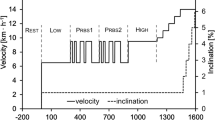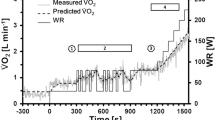Abstract
Purpose
The study compared the kinetic responses of heart rate (HR), pulmonary (\(\dot V\)O2pulm) and muscular oxygen uptake (\(\dot V\)O2musc) for upper (UpBody) and lower body (LoBody) exercise.
Methods
Eleven healthy men (24 ± 2 years, 184 ± 8 cm, 79 ± 7 kg) performed pseudo-random binary sequence (PRBS) work rate (WR) changes on a semi-recumbent cycle ergometer (30 and 80 W) and an arm cranking exercise device (20 and 50 W); followed by stepwise increases in WR (UpBody: 20 W 5 min−1; LoBody: 50 W 5 min−1). \(\dot V\)O2pulm was measured breath-by-breath and HR beat-to-beat. \(\dot V\)O2musc was estimated by the approach as reported by Hoffmann et al. (Eur J Appl Physiol 113:1745–1754, 2013), accounting for circulatory distortions. Time constants (τ) for HR (τHR), \(\dot V\)O2pulm (τ \(\dot V\)O2pulm) and \(\dot V\)O2musc (τ \(\dot V\)O2musc) were estimated during the PRBS phases by time-series analysis.
Results
Peak oxygen uptake differed significantly between UpBody (37.8 ± 5.0 ml min−1 kg−1) and LoBody exercises (56.1 ± 7.4 mL min−1 kg−1; p < 0.001). Significant differences were observed for τ \(\dot V\)O2musc (UpBody: 41.1 ± 11.3 s vs LoBody: 29.5 ± 5.2 s; p < 0.05), but not for τ \(\dot V\)O2pulm (49.1 ± 17.1 s vs 39.6 ± 11.2 s; p > 0.05) and τHR (29.1 ± 15.6 s vs 25.6 ± 8.0 s; p > 0.05).
Conclusions
Meaningful dissociations between \(\dot V\)O2pulm and \(\dot V\)O2musc kinetics exist for both UpBody and LoBody exercise during rapid work rate changes. Therefore, isolated \(\dot V\)O2pulm kinetic estimations without the consideration of the circulatory distortions may not allow a reliable assessment of \(\dot V\)O2musc kinetics.




Similar content being viewed by others
Abbreviations
- BCM:
-
Backward calculation method
- BF:
-
Breathing frequency
- CCF:
-
Cross-correlation function
- CCFlag :
-
Lag of CCFmax
- CCFmax :
-
Peak of cross-correlation function
- CO:
-
Cardiac output
- CPET:
-
Cardiopulmonary exercise testing
- HR:
-
Heart rate
- LTI:
-
Linear time-invariant model
- LoBody:
-
Lower body
- PRBS:
-
Pseudo-random binary sequence
- \(\dot Q\) rem :
-
Perfusion of non-exercising tissues
- SV:
-
Stroke volume
- τ :
-
Time constant of mono-exponential function
- TD:
-
Time delay of mono-exponential function
- UpBody:
-
Upper body
- \(\dot V\) E :
-
Ventilation
- \(\dot V\)O2max:
-
Maximal oxygen uptake capacity
- \(\dot V\)O2musc:
-
Exercising muscle oxygen uptake
- \(\dot V\)O2pulm:
-
Pulmonary oxygen uptake
- \(\dot V\)O2rem:
-
Oxygen uptake in non-exercising tissues
- V v :
-
Venous volume
- WR:
-
Work rate
References
Barstow TJ, Molé PA (1987) Simulation of pulmonary O2 uptake during exercise. J Appl Physiol 63:2253–2261
Barstow TJ, Lamarra N, Whipp BJ (1990) Modulation of muscle and pulmonary O2 uptakes by circulatory dynamics during exercise. J Appl Physiol 68:979–989
Beaver WL, Lamarra N, Wasserman K (1981) Breath-by-breath measurement of true alveolar gas exchange. J Appl Physiol 51:1662–1675
Behnke BJ, Barstow TJ, Kindig CA, McDonough P, Much TI, Poole DC (2002) Dynamics of oxygen uptake following exercise onset in rat skeletal muscle. Respir Physiol Neurobiol 133:229–239
Benson AP, Grassi B, Rossiter HB (2013) A validated model of oxygen uptake and circulatory dynamics interactions at exercise onset in humans. J Appl Physiol 115:743–755
Casaburi R, Barstow TJ, Robinson T, Wassermann K (1992) Dynamic and steady-state ventilatory and gas exchange response to arm exercise. Med Sci Sports Exerc 24:1365–1374
Cerretelli P, Shindell D, Pendergast DP, Prampero P, Rennie DW (1977) Oxygen uptake transients at the onset and offset of arm and leg work. Respir Physiol 30:81–97. doi:10.1016/0034-5687(77)90023-8
Cochrane JE, Hughson RL (1992) Computer simulation of O2 transport and utilization mechanisms at the onset of exercise. J Appl Physiol 73:2382–2388
Cowell SA, Stocks JM, Evans DG, Simonson SR, Greenleaf JE (2002) The exercise and environmental physiology of extravehicular activity. Aviat Space Environ Med 73:54–67
Day JR, Rossiter HB, Coats EM, Skasick A, Whipp BJ (2003) The maximally attainable \(\dot V\)O2 during exercise in humans: the peak vs. maximum issue. J Appl Physiol 95:1901–1907
Drescher U (2012) Entwicklung und Anwendung eines nicht-invasiven Verfahrens zur Abschätzung der muskulären Sauerstoffaufnahmekinetik im moderaten Belastungsbereich. German Sport University, Cologne, dissertation
Eßfeld D, Hoffmann U, Stegemann J (1991) A model for studying the distortion of muscle oxygen uptake patterns by circulation parameters. Eur J Appl Physiol Occup Physiol 62:83–90
Fortin J, Habenbacher W, Heller A, Hacker A, Grüllenberger R, Innerhofer J, Passath H, Wagner Ch, Haitchi G, Flotzinger D, Pacher R, Wach P (2006) Non-invasive beat-to-beat cardiac output monitoring by an improved method of transthoracic bioimpedance measurement. Comput Biol Med 36:1185–1203
Gollnick PD, Armstrong B, Saubert CW, Saltin B (1972) Enzyme activity and fiber composition in skeletal muscle of untrained and trained men. J Appl Physiol 33:312–319
Grassi B, Poole DC, Richardson RS, Knight DR, Erickson BK, Wagner P (1996) Muscle O2 uptake kinetics in humans: implications for metabolic control. J Appl Physiol 80:988–998
Grassi B, Gladden LB, Samaja M, Stary CM, Hogan MC (1998a) Faster adjustments of O2 delivery does not affect \(\dot V\)O2 on-kinetics in isolated in situ canine muscle. J Appl Physiol 85:1394–1403
Grassi B, Gladden LB, Stary CM, Wagner PD, Hogan MC (1998b) Peripheral O2 diffusion does not affect \(\dot V\)O2 on-kinetics in isolated in situ canine muscle. J Appl Physiol 85:1404–1412
Hoffmann U, Drescher U, Benson AP, Rossiter HB, Essfeld D (2013) Skeletal muscle \(\dot V\)O2 kinetics from cardio-pulmonary measurements: assessing distortions through O2 transport by means of stochastic work-rate signals and circulatory modelling. Eur J Appl Physiol 113:1745–1754. doi:10.1007/s00421-013-2598-7
Johnson MA, Polgar J, Weightman D, Appleton D (1973) Data on the distribution of fibre types in thirty-six human muscles. J Neurol Sci 18:111–129. doi:10.1016/0022-510X(73)90023-3
Koga S, Shiojiri T, Shibasaki M, Fukuba Y, Fukuoka Y, Kondo N (1996) Kinetics of oxygen uptake and cardiac output at onset of arm exercise. Respir Physiol 103:195–202. doi:10.1016/0034-5687(95)00082-8
Koppo K, Bouckaert J, Jones AM (2002) Oxygen uptake kinetics during high-intensity arm and leg exercise. Respir Physiol Neurobiol 133:241–250
Lador F, Kenfack MA, Moia C, Cautero M, Morel DR, Capelli C, Feretti G (2006) Simultaneous determination of the kinetics of cardiac output, systemic O2 delivery, and lung O2 uptake at exercise onset in men. Am J Physiol Regul Integr Comp Physiol 290:R1071–R1079
Myers J (2005) Applications of cardiopulmonary exercise testing in the management of cardiovascular and pulmonary disease. Int J Sports Med 26:S49–S55
Pendergast DR (1989) Cardiovascular, respiratory, and metabolic response to upper body exercise. Med Sci Sports Exerc 21:121–125
Pendergast DR, Shindell D, Cerretelli P, Rennie DW (1980) Role of central and peripheral circulatory adjustments in oxygen transport at the onset of exercise. Int J Sports Med 1:160–170
Poole DC, Jones AM (2005) Towards an understand of the mechanistic bases of \(\dot V\)O2 kinetics. In: Jones AM, Poole DC (eds) Oxygen uptake kinetics in sport, exercise and medicine. Routledge, New York, pp 294–328
Saltin B, Hendriksson J, Nygaard E, Andersen P (1977) Fiber types and metabolic potentials of skeletal muscle in sedentary man and endurance runners. Ann N Y Acad Sci 301:3–29
Sanada K, Kearns CF, Kojima K, Abe T (2005) Peak oxygen uptake during running and arm cranking normalized to total and regional skeletal muscle mass measured by magnetic resonance imaging. Eur J Appl Physiol 93:687–693
Sawka MN (1989) Upper body exercise: physiology and practical considerations. Med Sci Sports Exerc 21:119–120
Sawka MN, Pandolf KB (1991) Upper body exercise: physiology and training application for human presence in space. SAE International. Eng Soc Adv Mobil Land Sea Air Space 7(1):1–19
Sawka MN, Foley ME, Pimental NA, Toner MM, Pandolf KB (1983) Determination of maximal aerobic power during upper-body exercise. J Appl Physiol Respir Environ Exerc Physiol 54:113–117
Schneider DA, Wing AN, Morris NR (2002) Oxygen uptake and heart rate kinetics during heavy exercise: a comparison between arm cranking and leg cycling. Eur J Appl Physiol 88:100–106
Acknowledgments
The study was supported by the DLR (Deutsches Zentrum für Luft- und Raumfahrt), Germany (FKZ 50WB0726). We thank David Loosen and Benjamin Baak for support during the exercise tests and for data preparation.
Conflict of interest
The authors declare that they have no conflict of interest
Author information
Authors and Affiliations
Corresponding author
Additional information
Communicated by Guido Ferretti.
Rights and permissions
About this article
Cite this article
Drescher, U., Koschate, J. & Hoffmann, U. Oxygen uptake and heart rate kinetics during dynamic upper and lower body exercise: an investigation by time-series analysis. Eur J Appl Physiol 115, 1665–1672 (2015). https://doi.org/10.1007/s00421-015-3146-4
Received:
Accepted:
Published:
Issue Date:
DOI: https://doi.org/10.1007/s00421-015-3146-4




